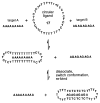Recognition of DNA, RNA, and Proteins by Circular Oligonucleotides
- PMID: 19946615
- PMCID: PMC2782786
- DOI: 10.1021/ar9602462
Recognition of DNA, RNA, and Proteins by Circular Oligonucleotides
Figures










References
-
- Watson JD, Hopkins NH, Roberts JW, Steitz JA, Weiner AM. Molecular Biology of the Gene. 4. Benjamin/Cummings; Menlo Park, CA: 1987. p. 193.
-
- Diener TO. Trends Microbiol. 1993;1:289. - PubMed
-
-
There is a single report of a cyclic double-stranded DNA of 42 base pairs: Wolters M, Wittig B. Nucleic Acids Res. 1989;17:5163.
-
Grants and funding
LinkOut - more resources
Full Text Sources
Other Literature Sources
